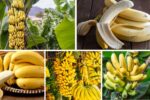Mangoes, often called the “king of fruits,” are loved for their sweet flavor, juicy texture, and tropical aroma. They’re not just a fruit; they’re a cultural and culinary icon in many countries. From fresh slices in summer to mango smoothies, pickles, and desserts, mangoes hold a special place in global kitchens. But have you ever wondered which country produces the most mangoes in the world? The answer is India, and the numbers are astonishing. Let’s explore how India dominates global mango production, what varieties it offers, and why this tropical fruit is so significant to its economy and culture.
Global Mango Production at a Glance

The mango is native to South Asia, and its cultivation has now spread across the tropical and subtropical regions of the world. According to the latest FAO (Food and Agriculture Organization) data, mango production exceeds 55 million metric tons annually worldwide. While countries like China, Thailand, Indonesia, and Mexico are key players, one nation far surpasses all others—India, producing more than 40% of the world’s mangoes.
India: The World’s Mango Powerhouse
India’s love affair with mangoes is centuries old, with historical records dating back to 2000 BCE. Ancient Indian kings were known to plant entire mango orchards, and even today, mangoes remain deeply rooted in India’s agriculture, festivals, and trade.
- Production Figures: India produces approximately 25–27 million metric tons of mangoes annually.
- Global Share: Around 45–48% of total global mango production.
- Cultivation Area: Over 2.3 million hectares are dedicated to mango farming.
- States Leading the Production: Uttar Pradesh, Andhra Pradesh, Telangana, Karnataka, Bihar, and Gujarat are the top contributors.
Popular Mango Varieties in India

India is home to over 1,000 different varieties of mangoes, each with its unique flavor, color, and texture. Some of the most famous include:
- Alphonso (Hapus) – Known as the “King of Mangoes,” grown mainly in Maharashtra, famous for its rich sweetness and saffron-colored flesh.
- Dasheri – Cultivated in Uttar Pradesh, known for its honey-like sweetness.
- Kesar – Grown in Gujarat, bright orange, aromatic, and popular in desserts.
- Langra – Originating from Varanasi, known for its greenish skin and tangy-sweet flavor.
- Banganapalli (Benishan) – Large-sized mango from Andhra Pradesh, sweet and fiberless.
- Totapuri – Recognized for its parrot-beak shape, often used in pickles and pulp production.
Climate and Conditions for Mango Farming in India
India’s dominance in mango production can be credited to its ideal climate and diverse growing regions. Mango trees require:
- Temperature: 24–30°C for optimal flowering and fruiting.
- Rainfall: Moderate rainfall (75–250 cm annually), with a dry period before flowering.
- Soil: Well-drained, deep loamy soils rich in organic matter.
- Sunlight: Full sun exposure for healthy fruit development.
From coastal plains to inland river valleys, India’s varied geography allows year-round mango cultivation in different regions.
Economic Importance of Mango Production
Mango farming is not only a cultural passion in India but also a major economic driver.
- Employment: Millions of farmers, traders, and workers depend on mango cultivation for their livelihood.
- Domestic Market: India consumes most of its mango production domestically. Mango season (April–July) sees massive demand across all states.
- Export: India exports over 50,000–60,000 metric tons of fresh mangoes annually, with major markets including the USA, UAE, UK, Saudi Arabia, and Japan.
- Mango-based Products: Apart from fresh fruit, India produces mango pulp, juices, pickles, jams, and dried mango slices, further boosting the agro-processing sector.
Cultural Significance of Mangoes in India

Mangoes are deeply woven into Indian traditions and festivals:
- Symbol of Prosperity: Mango leaves are used in Hindu religious ceremonies and as decorations during weddings.
- Mythology: Mangoes are associated with love, fertility, and prosperity in Indian folklore.
- Gifts: Mango baskets are often exchanged as gifts during summer.
- Cuisine: From aamras (sweet mango pulp) to mango lassi and spicy mango chutney, the fruit dominates Indian summer menus.
Challenges in Mango Production

Despite being the largest producer, India faces challenges in mango farming:
- Post-Harvest Losses: Nearly 20–30% of mangoes are lost due to poor storage and handling.
- Climate Change: Unpredictable rainfall and temperature variations affect flowering and yield.
- Pest & Diseases: Fruit flies, anthracnose, and powdery mildew are common threats.
- Export Barriers: Stringent quality checks and fumigation requirements in some countries limit export volumes.
Government Initiatives to Boost Mango Production

To address these challenges, the Indian government and agricultural bodies have introduced several initiatives:
- National Horticulture Mission (NHM): Promotes better cultivation practices and orchard rejuvenation.
- Post-Harvest Infrastructure: Establishing cold storage chains and ripening chambers.
- Research: Developing disease-resistant and high-yield varieties.
- Export Promotion: Training farmers to meet international quality standards.
Other Leading Mango-Producing Countries
While India is the undisputed leader, several other countries also contribute significantly to global mango production:
- China – Produces around 4–5 million metric tons, mainly in southern provinces like Hainan and Guangxi.
- Thailand – Famous for its Nam Dok Mai and Keo Savoy varieties, producing 3–4 million metric tons annually.
- Indonesia – Produces around 2.5 million metric tons, with high domestic consumption.
- Pakistan – Known for Sindhri and Chaunsa varieties, producing about 2–2.5 million metric tons.
- Mexico – Leading exporter to the USA, producing over 2 million metric tons annually.
Why India Will Continue to Lead Mango Production
Several factors make it likely that India will remain the top mango producer in the foreseeable future:
- Vast cultivation area and favorable climate.
- Deep cultural and economic integration of mango farming.
- Growing domestic demand.
- Continuous investment in improved farming techniques and infrastructure.
Conclusion
Mangoes are more than just a fruit in India—they’re a symbol of culture, heritage, and pride. With nearly half of the world’s production, India’s dominance in mango cultivation is unmatched. While challenges remain in storage, transport, and export, the country’s passion for this fruit ensures that mango farming will continue to thrive. Whether you enjoy the creamy Alphonso, the tangy Langra, or the aromatic Kesar, remember that it’s likely your mango came from the fields of India—the true kingdom of the “king of fruits.”






Leave A Comment